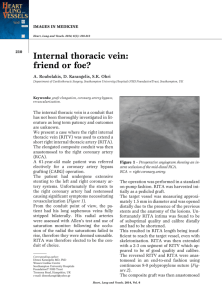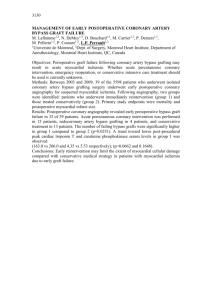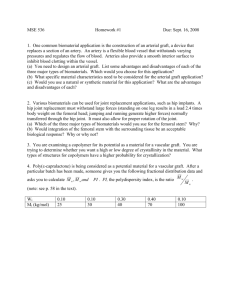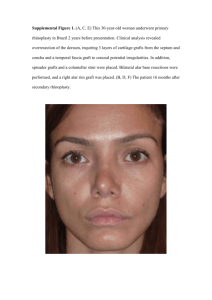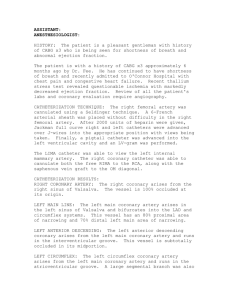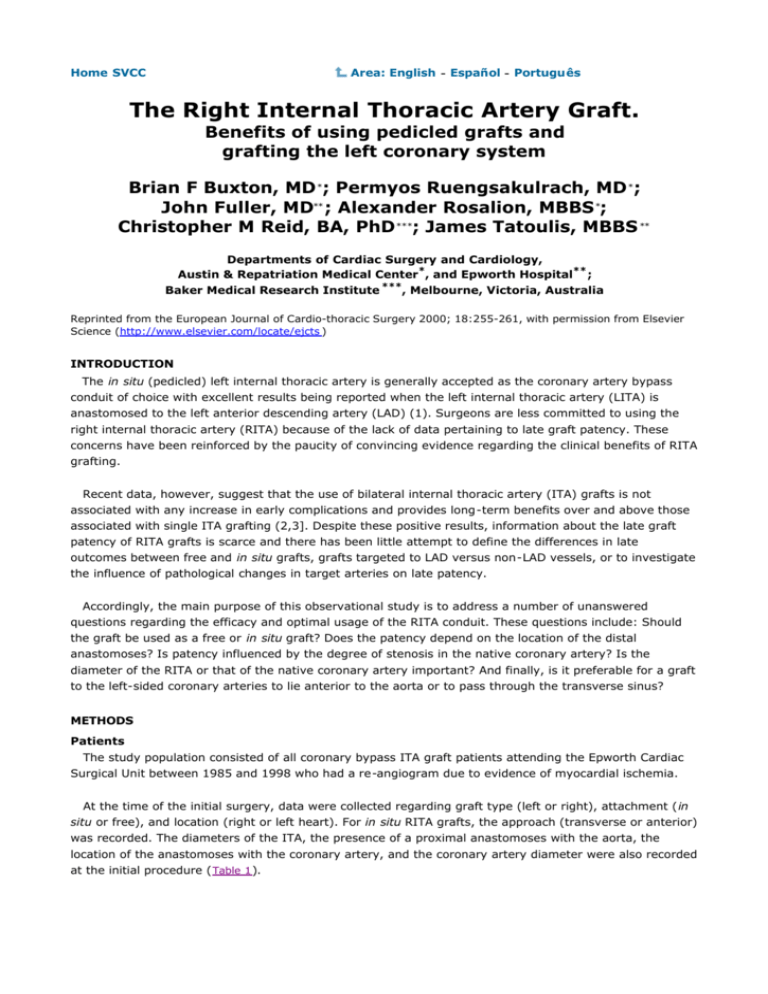
Home SVCC
Area: English
- Español - Português
The Right Internal Thoracic Artery Graft.
Benefits of using pedicled grafts and
grafting the left coronary system
Brian F Buxton, MD *; Permyos Ruengsakulrach, MD *;
John Fuller, MD** ; Alexander Rosalion, MBBS *;
Christopher M Reid, BA, PhD ***; James Tatoulis, MBBS **
Departments of Cardiac Surgery and Cardiology,
Austin & Repatriation Medical Center*, and Epworth Hospital** ;
Baker Medical Research Institute ***, Melbourne, Victoria, Australia
Reprinted from the European Journal of Cardio-thoracic Surgery 2000; 18:255-261, with permission from Elsevier
Science (http://www.elsevier.com/locate/ejcts )
INTRODUCTION
The in situ (pedicled) left internal thoracic artery is generally accepted as the coronary artery bypass
conduit of choice with excellent results being reported when the left internal thoracic artery (LITA) is
anastomosed to the left anterior descending artery (LAD) (1). Surgeons are less committed to using the
right internal thoracic artery (RITA) because of the lack of data pertaining to late graft patency. These
concerns have been reinforced by the paucity of convincing evidence regarding the clinical benefits of RITA
grafting.
Recent data, however, suggest that the use of bilateral internal thoracic artery (ITA) grafts is not
associated with any increase in early complications and provides long-term benefits over and above those
associated with single ITA grafting (2,3]. Despite these positive results, information about the late graft
patency of RITA grafts is scarce and there has been little attempt to define the differences in late
outcomes between free and in situ grafts, grafts targeted to LAD versus non-LAD vessels, or to investigate
the influence of pathological changes in target arteries on late patency.
Accordingly, the main purpose of this observational study is to address a number of unanswered
questions regarding the efficacy and optimal usage of the RITA conduit. These questions include: Should
the graft be used as a free or in situ graft? Does the patency depend on the location of the distal
anastomoses? Is patency influenced by the degree of stenosis in the native coronary artery? Is the
diameter of the RITA or that of the native coronary artery important? And finally, is it preferable for a graft
to the left-sided coronary arteries to lie anterior to the aorta or to pass through the transverse sinus?
METHODS
Patients
The study population consisted of all coronary bypass ITA graft patients attending the Epworth Cardiac
Surgical Unit between 1985 and 1998 who had a re-angiogram due to evidence of myocardial ischemia.
At the time of the initial surgery, data were collected regarding graft type (left or right), attachment (in
situ or free), and location (right or left heart). For in situ RITA grafts, the approach (transverse or anterior)
was recorded. The diameters of the ITA, the presence of a proximal anastomoses with the aorta, the
location of the anastomoses with the coronary artery, and the coronary artery diameter were also recorded
at the initial procedure ( Table 1 ).
Whilst the focus of this paper is on RITA graft utility, a comparison of RITA with LITA to the left anterior
descending artery was undertaken as the LITA graft is regarded as the standard in bypass graft surgery.
To ensure the independence of the two patient groups, the LITA comparison group consisted of patients
receiving a LITA graft only (n=530). The RITA group was divided into categories to address the following
questions: a) the difference in graft patency between left versus right ITA grafts; b) the difference in graft
patency for in situ versus free RITA grafts; c) the difference in graft patency for in situ RITA grafts to the
right versus the left coronary system; d) the difference in graft patency for in situ RITA grafts to the left
coronary arteries passed via the anterior versus the transverse route.
Surgical technique - initial procedure
Following a conventional sternotomy, the LITA and then the RITA were harvested with a pedicle
containing the pleura, the transversus thoracis muscle and fascia, and the internal thoracic veins. On the
right side, the internal thoracic vein was mobilized to its termination with the right brachiocephalic vein.
The upper branches of the ITA, including the pericardiacophrenic artery, were ligated with small clips
adjacent to the ITA. The pedicle was sprayed with 2 mmol of a solution containing 80mg/100ml
papaverine and Ringer's lactate solution. Following the transection of either the lower end of the RITA
pedicle or its terminal branches, and prior to implantation, the free flow was checked to exclude any
proximal obstruction. Two to three cc of the papaverine and Ringer's lactate solution was diluted with an
equal volume of blood (1mmol/l, pH 7.4) and was injected into the distal end of the ITA or one of its
terminal branches. The distal end was then clipped using hemostatic clips (Weck hemoclip North Carolina,
USA) and allowed to distend under arterial pressure.
Prior to the commencement of cardiopulmonary bypass, the right pedicle was passed through a window
in the right pleura and pericardium, immediately anterior to the phrenic nerve, and its length assessed in
relation to the left or right coronary artery system. If deemed inadequate, the right internal thoracic vein
was used as a free graft.
Cardiopulmonary bypass was performed at 28oC until 1990 and subsequently at 32oC. Prior to 1991,
antegrade cardioplegia was used at 15 to 20 minute intervals. Since 1991, combined antegrade and
retrograde blood cardioplegia at 25oC has been employed, using a single cross clamp for all distal and
proximal anastomoses. While dilatation of the arterial grafts initially relied on topical papaverine, more
recently the systemic vasodilator nitroglycerine or the phosphodiesterase III inhibitor (milrinone) has been
used in addition to topical agents to produce a cardiac index of 3 l.min-1 .m-2 .
Graft strategy
From 1985 to 1988, the RITA was used as an in situ graft where possible. Initially, the RITA was
anastomosed distally to the trunk of the right coronary artery, or to its acute marginal or posterior
descending branches. From 1988 to 1994, preference was given to using the RITA as a free graft because
of its flexibility. From 1995, the RITA was used more frequently as an in situ graft to the left side (to the
LAD or diagonal coronary arteries). The graft was passed anterior to the ascending thoracic aorta, through
the pericardium and behind the thymus, or through the transverse sinus to the intermediate or circumflex
marginal coronary arteries. The LITA was usually grafted to the LAD. When the RITA was anastomosed to
the LAD, the LITA was sutured to the diagonal, intermediate or, more commonly, to the circumflex
marginal branches by passing either anterior or posterior to the left phrenic nerve (4). All distal
anastomoses were performed using 7/0 polypropylene sutures. Sequential anastomoses were seldom
performed. Proximal anastomoses, if required, were performed directly with the ascending thoracic aorta
using a continuous 6/0 polypropylene suture. Postoperatively, the mean arterial pressure was maintained
at 70 mmHg or above, with a cardiac index of over 2 l.min-1 .m -2 and a systemic vascular resistance of
greater than 800 to 1,000 dynes.sec.cm-5 .
Follow-up
Clinical follow-up data were obtained from office visits to the surgeon, cardiologist or general
practitioner; by telephone interview; and by routine mail-out every two years. Postoperative coronary
angiography was undertaken to assess any symptoms or cardiac events suggesting ischemia. Angiographic
results were obtained from the cardiologist or directly from the angiographic laboratory. In addition to the
surgeon's evaluation, graft patency was assessed independently by a cardiologist and a radiologist. Graft
failure was defined as occlusion or stenosis > (greater than or equal to) 80%.
Statistical analysis
Data were collected by one of the investigators (JF), verified and entered into a dBase IV database
program. All analyses were conducted using SAS Ver 6.12 statistical software. Patient characteristics were
determined using group descriptive statistics.
Survival analysis methods were used based on time to re-angiogram and graft failure as the outcome
event. In addition, a multivariate analysis was conducted to identify intraoperative predictors of RITA graft
failure. Comparisons were adjusted for the changes in operational technique occurring during the course of
the data collection period. Adjusting for time of operation did not influence the statistical significance of
reported comparisons, hence un-adjusted data are presented. Estimated risk ratios (RR) and 95%
confidence intervals (CI) are reported and statistical significance is based on the Wald Chi-square statistic.
Unless specified, continuous data are expressed as mean ± standard deviation.
RESULTS
Between 1985 and 1998, 962 patients who had previously had coronary artery bypass grafting
underwent re-angiography because of myocardial ischemia. The mean age of these patients at the time of
the initial graft procedure was 59.6 ± 8.5 years. The mean re-angiography interval was 67.0 ± 39.4
months postoperatively (range 0.1-169.5 months).
Five hundred and thirty patients had LITA grafts only and 432 patients had both RITA and LITA grafts.
Of these 432 RITA grafts, 241 were in situ and 191 were free grafts. Of the in situ RITA grafts, 123 were
to the right heart and 118 to the left heart. Of the in situ RITA grafts to the left heart, 62 were placed via
the transverse and 56 via the anterior route. The demographic, intraoperative, and postoperative
characteristics of patients in each of these observational groups are summarized in Table 2 . At the time of
re-angiogram, 72 graft failures were identified, 15 in the LITA graft group and 57 in the RITA group.
Patency of in situ RITA and LITA grafts to the LAD
The graft patency survival curves for in situ RITA and LITA grafts to the LAD, shown in Fig. 1, are almost
identical (RR 1.0 (95% CI, 0.2-4.7) P=0.98).
RITA graft utility
Within the RITA group, in situ compared with free RITA grafts tended to show a superior patency with a
15% reduction in graft failure (RR 0.7 (95% CI, 0.4-1.1) P=0.1308). For RITA grafts to the left coronary
system, in situ grafts also tended to be superior to free grafts (RR 0.4 (95% CI, 0.2-1.0) p=0.037);
however, this difference was not observed for RITA grafts to the right coronary system (RR 0.9 (95% CI,
0.4 -1.9) p=0.69). Overall, in situ RITA grafts to the left coronary system tended to fail less than in situ
grafts to the right heart (RR 1.8 (95% CI, 0.8-3.8) p=0.1270).
For RITA grafts to the left coronary system, those that passed anterior to the aorta were associated with
a higher risk of failure compared with those that passed through the transverse sinus. This difference was
not statistically significant (RR 2.1 (95% CI, 0.4-10.3) p=0.3699).
Intraoperative predictors of RITA graft failure
Of the 432 RITA grafts, 57 failed (13%). Predictor variables for graft failure are shown in Table 3 . Fig. 2a
shows the cumulative patency curves for each of the RITA anastomotic sites. There was an increase in the
risk of graft failure associated with using any alternative site to the LAD with the relative risk associated
with using the right coronary artery graft almost reaching statistical significance (RR 4.0 (95% CI, 0.917.4) P=0.06; Table 3 ).
The degree of stenosis of the coronary artery was inversely related to graft patency failure. In
comparison with a stenosis of 80% or more, a stenosis of less than 60% incurred an almost four-fold
increase in risk (RR 3.8 (95% CI, 1.9-7.2) P=0.0001), while a stenosis of 60-79% incurred a 37% increase
in risk (RR 1.4 (95% CI, 0.7-2.7) P=0.36; Table 3). Fig. 2b illustrates the cumulative graft patency
associated with the degree of stenosis of the coronary artery at the time of surgery.
Proximal attachment to the aorta resulted in a two-fold increase in the risk of graft failure compared
with an in situ graft (RR 1.9 (95% CI, 1.0-6.0) P=0.06; Fig. 2c, Table 3 ).
DISCUSSION
While the RITA has been used as a coronary artery bypass graft for nearly 30 years, there is a still some
debate in the literature over the best approach to using this conduit. The RITA was employed initially as an
in situ graft. In some situations, however, the length of the RITA is insufficient to reach the desired
position on the target artery. Insufficient length may be overcome by detaching the RITA and using it as a
free graft or by adding an additional conduit through a procedure known as graft extension (5). In 1996,
Verhelst and colleagues found that the graft patency was lower if the RITA was used as a free graft and
recommended that it be used as a pedicle (in situ) where possible (6). Our results support these findings.
Free grafts, anastomosed to the aorta, have an increased graft failure rate at both early and late stages
postoperatively suggesting that there may be early technical factors and ongoing problems with graft flow
compromising the patency of the free graft. Attachment of the free RITA to the in situ LITA may overcome
these problems; however, this procedure needs to be further evaluated. Although the late patency rates of
free grafts are not as satisfactory as those of in situ grafts, they still appear to be superior to the results
reported for saphenous vein grafts (7,8)
The target artery has also been recognized as an important determinant of ITA graft patency. The
excellent patency of both right and left ITAs when grafted to the LAD has been demonstrated by a number
of studies (9, 10), a finding we have replicated in this investigation. The results of grafting non-LAD
systems, however, have been less consistent and more controversial. Bezon and colleagues in 1998 and
Chow and colleagues in 1994, found that anatomizing the RITA to the circumflex system was less
satisfactory than grafting it to the LAD (11,12). Rankin and colleagues in 1986 and Dietl and associates in
1995 reported high failure rates when the posterior descending coronary artery was grafted with an in situ
RITA and suggested that the right gastroepiploic artery was a preferable target vessel (9,13). Our choice is
to graft the left-sided coronary arteries with an in situ RITA where possible.
The in situ RITA may be routed to the left side anterior to the aorta or through the transverse sinus. The
anterior route allows us to use the in situ RITA to graft the LAD. Studies have shown that the utility of the
in situ RITA grafted to the left coronary system can be further extended by passing it posteriorly through
the transverse sinus, a procedure that provides a satisfactory long term outcome (12,14-18). The results
of our study also supported this finding. A theoretical objection to the anterior route is that it may
compromise a subsequent re-operation for coronary artery disease or aortic valve replacement. In our
experience this has not proved to be a problem. The RITA when passed anterior to the aorta lies within the
pericardium posterior to the thymus and is applied to the aorta, which it crosses near the site for aortic
cannulation. The excellent patency of in situ RITA grafts applied to the LAD anterior to the aorta outweighs
any theoretical objection.
Competitive flow is perceived to be a problem using the bypass technique. Although there are numerous
anecdotal reports (19-21), there are few data that relate patency to the degree of the original coronary
artery stenosis (22-23). Our analysis confirms the increased hazard when lesions with a low-grade
stenosis are grafted.
This detailed analysis of the late patency of the RITA and its complex relationship with the coronary
artery variables provides key information by which grafting strategies can be optimized. In particular, this
study confirms the durability of the in situ RITA and therefore its potential for preventing the late
complications following coronary artery surgery. In planning a coronary reconstruction, the RITA should
assume the same important role as that of the LITA. For instance, an in situ RITA that reaches the desired
location on the LAD may be used in preference to the LITA, which may then be deployed elsewhere, for
example, to a large marginal branch. Alternatively, the situ RITA may be anastomosed to another left
sided coronary artery, or used as a free graft.
In summary: (1) When the in situ RITA is anastomosed to the LAD the results are similar to those of
LITA grafting. (2) Grafting the RITA to an artery with a low-grade stenosis markedly increases the risk of
graft failure. (3) Overall, an increased risk of graft failure is associated with grafting non-LAD arteries, in
particular, the right coronary artery. (4) This study suggests it may be beneficial to use in situ rather than
free RITA grafts. (5) Neither the diameter of the ITA nor that of the coronary artery predicted graft
patency.
CONCLUSION
The RITA is an excellent coronary artery bypass graft. To obtain the best long-term patency, the RITA
should be grafted to a coronary artery with a high-grade stenosis or occlusion. It may be preferable to use
the RITA as an in situ graft, however, this observation requires further substantiation. Passing the in situ
RITA either anterior or posterior to the aorta gives a satisfactory result.
LIMITATIONS OF THE STUDY
Although Cox proportional hazard models may provide a valuable assessment of the relationship
between the various predictors and patency subgroups, it is important to recognize that these techniques
are based on a number of assumptions that may have biased the results. Selection for re-angiography by
using markers of ischemia may have resulted in the inclusion of a relatively high proportion of patients
with advanced disease. The analyses were confined to the important intraoperative surgical variables and,
like any retrospective study, other important predictors, for example, patient variables that were not
included may have influenced the outcome. Furthermore, when using the Cox model, the time to graft
failure and the time to angiography are assumed to be the same, when, in reality, graft failure may have
occurred previously. Also, while some patients have had multiple angiograms, in this study only the time
to the first graft failure was recorded so that subsequent angiographic data that may have contained
important information were not included.
ABSTRACT
Objective: The left internal thoracic artery (LITA), when grafted to the left anterior descending artery (LAD), is
generally accepted as the conduit of first choice for coronary artery bypass grafting (CABG). The role and efficacy of
the right internal thoracic artery (RITA), despite its long-term use as a coronary artery graft, is relatively less
understood. Accordingly, in this study, we sought to assess the utility of the RITA as a coronary conduit by
examining the long-term patency of both in situ and aorto -coronary free RITA grafts. We examined the association
between intraoperative graft and coronary artery variables.
Methods: Nine hundred and sixty-two patients (LITA 962, RITA 432) who had CABG between 1985 and 1998 and
underwent re-angiography for evidence of myocardial ischemia were included in this observational analysis. The
diameter of the internal thoracic artery (ITA), the presence of a proximal anastomoses with the aorta, the location
of the anastomoses with the coronary artery, and the coronary artery diameter, were recorded at the initial
procedure. The mean follow-up was 67.0 ± 39.4 months (range 0.1-169.5). The relationship between
intraoperative variables and graft patency was assessed using Cox proportional hazard models.
Results: Highest RITA failure rates were associated with grafting a native coronary artery with a stenosis of less
than 60% compared with 80-100% (RR 3.8 (95% CI, 1.9-7.2) P=0.0001). Grafts to non-LAD arteries had a higher
risk of failure, the highest risk ratio being associated with grafting the right coronary artery (RR 4.0 (95% CI, 0.917.4) P=0.06). Free compared with in situ grafts were also associated with a higher risk of failure with this result
bordering on statistical significance (RR 1.9 (95% CI, 1.0-6.0) P=0.06).
Conclusion : Preference should be given to grafting arteries with a high grade stenosis or occlusion, to grafting left
rather than right coronary arteries, and to using in situ rather than free ITA grafts. Passing the RITA to the left,
either anterior to the aorta or through the transverse sinus, did not influence patency.
ACKNOWLEDGEMENTS
The authors gratefully acknowledge the cardiac surgeons Peter Skillington, John Goldblatt, George Matalanis, Serge
Lubicz and Don Esmore at the Austin & Repatriation Medical Centre and the Epworth Hospital for their cooperation
and help; Dr Tania Lewis for her editorial excellence; and Janifer van Vliet for coordinating the hand-out and
retrieval of patient clinical re-angiograms to date.
REFERENCES
1. Mack MJ, Osborne JA, Shennib H. Arterial graft patency in coronary artery bypass grafting: what do we really
know? Ann Thorac Surg 1998;66:1055-9.
2. Buxton BF, Komeda M, Fuller JA, Gordon I. Bilateral internal thoracic artery grafting may improve outcome of
coronary artery surgery. Risk -adjusted survival. Circulation 1998;98(Suppl. II):1-6.
3. Lytle BW, Blackstone EH, Loop FD, Houghtaling PL, Arnold JH, Akhrass R, McCarthy PM, Cosgrove DM. Two
internal thoracic artery grafts are better than one. J Thorac Cardiovasc Surg 1999;117:855-72.
4. Buxton B, Knight S. Retrophrenic location of the internal mammary artery graft. Ann Thorac Surg
1990;49:1011-2.
5. Calafiore AM, Di Giammarco G, Luciani N, Maddestra N, Di Nardo E, Angelini R. Composite arterial conduits
for a wider arterial myocardial revascularization. Ann Thorac Surg 1994;58:185 -90.
6. Verhelst R, Etienne PY, El Khoury G, Noirhomme P, Rubay J, Dion R. Free internal mammary artery graft in
myocardial revascularization. Cardiovasc Surg 1996;4:212 -6.
7. Grondin CM, Campeau L, Lesperance J, Enjalbert M, Bourassa MG. Comparison of late changes in internal
mammary artery and saphenous vein grafts in two consecutive series of patients 10 years after operation.
Circulation 1984;70(3Pt2):I208-12.
8. Tatoulis J, Buxton BF, Fuller JA. Results of 1,454 free right internal thoracic artery-to-coronary artery grafts.
Ann Thorac Surg 1997;64:1263-8.
9. Rankin JS, Newman GE, Bashore TM, Muhlbaier LH, Tyson GS Jr, Ferguson TB Jr, Reves JG, Sabiston DC Jr.
Clinical and angiographic assessment of complex mammary artery bypass grafting. J Thorac Cardiovasc Surg
1986;92:832-46.
10. Nishida H, Tagusari O, Yamaki F, Hayashi K, Hirota J, Koyanagi T, Shiikawa A, Nakano K, Endo M, Koyanagi
H. A right internal thoracic artery graft to the left anterior descending artery. Kyobu Geka 1993;46:206-9.
11. Bezon E, Karaterki A, Barra JA. Failure of coronary artery bypass with the internal thoracic artery. Does
extended use of the internal thoracic artery affect the patency of the coronary artery? Arch Mal Coeur Vaiss
1998;91:1139-44.
12. Chow MS, Sim E, Orszulak TA, Schaff HV. Patency of internal thoracic artery grafts: comparison of right
versus left and importance of vessel grafted. Circulation 1994;90(5 Pt 2):II129-32.
13. Dietl CA, Benoit CH, Gilbert CL, Woods EL, Pharr WF, Berkheimer MD, Madigan NP, Menapace FJ. Which is
the graft of choice for the right coronary and posterior descending arteries? Comparison of the right internal
mammary artery and the right gastroepiploic artery. Circulation 1995;92(Suppl. II):92 -7.
14. Ura M, Sakata R, Nakayama Y, Arai Y, Saito T. Long -term patency rate of right internal thoracic artery
bypass via the transverse sinus. Circulation 1998; 98:2043-8.
15. Gerola LR, Puig LB, Moreira LF, Cividanes GV, Gemha GP, Souto RC, Oppi EC, Souza AH. Right internal
thoracic artery through the transverse sinus in myocardial revascularization. Ann Thorac Surg 1996;61:170812.
16. Ueyama K, Sakata R, Umebayashi Y, Nakayama Y, Arakaki K, Ura M. In situ right internal thoracic artery
graft via transverse sinus for revascularization of posterolateral wall: early results in 116 cases. J Thorac
Cardiovasc Surg 1996;112:731-6.
17. Puig LB, Papanikolau CG, Najar MP, Cividanes GV, Souto RC, Puig JC, Brandao CM, Rossini RC, Oppi EC. The
use of left and right internal thoracic artery grafts for revascularization of the left coronary artery. Arq Bras
Cardiol 1997;68:437-42.
18. Sakata R, Ura M, Nakayama Y, Arai Y. In situ right internal thoracic artery graft for revascularization of
circumflex artery. Early results and long-term angiographic follow up. Jpn J Thorac Cardiovasc Surg
1999;47:273-6.
19. Nasu M, Akasaka T, Okazaki T, Shinkai M, Fujiwara H, Sono J, Okada Y, Miyamoto S, Nishiuchi S, Yoshikawa
J, Shomura T. Postoperative flow characteristics of left internal thoracic artery grafts. Ann Thorac Surg
1995;59:154-62.
20. Kawasuji M, Sakakibara N, Takemura H, Tedoriya T, Ushijima T, Watanabe Y. Is internal thoracic artery
grafting suitable for a moderately stenotic coronary artery? J Thorac Cardiovasc Surg 1996;112:253 -9.
21. Pagni S, Storey J, Ballen J, Montgomery W, Chiang BY, Etoch S, Spence PA. ITA versus SVG: a comparison
of instantaneous pressure and flow dynamics during competitive flow. Eur J Cardiothorac Surg 1997;11:108692.
22. Cosgrove DM, Loop FD, Saunders CL, Lytle BW, Kramer JR. Should coronary arteries with less than fifty
percent stenosis be bypassed? J Thorac Cardiovasc Surg 1981;82:520-30.
23. Hashimoto H, Isshiki T, Ikari Y, Hara K, Saeki F, Tamura T, Yamaguchi T, Suma H. Effects of competitive
blood flow on arterial graft patency and diameter. Medium -term postoperative follow-up. J Thorac Cardiovasc
Surg 1996;111:399-407.
Single copies of this article can be downloaded and printed for the reader's personal research and
study.
Top
Your questions, contributions and commentaries will be answered
by the lecturer or experts on the subject in the Cardiovascular Surgery list.
Please fill in the form (in Spanish, Portuguese or English) and press the "Send" button.
Question,
contribution
or commentary:
Name and Surname:
Country: Argentina
E-Mail address: @
Send
Erase
Top
2nd Virtual Congress of Cardiology
Dr. Florencio Garófalo
Dr. Raúl Bretal
Dr. Armando Pacher
Steering Committee
President
Scientific Committee
President
Technical Committee - CETIFAC
President
fgaro@fac.org.ar
fgaro@satlink.com
rbretal@fac.org.ar
rbretal@netverk.com.ar
apacher@fac.org.ar
apacher@satlink.com
Copyright© 1999-2001 Argentine Federation of Cardiology
All rights reserved
This company contributed to the Congress:



